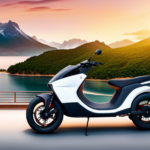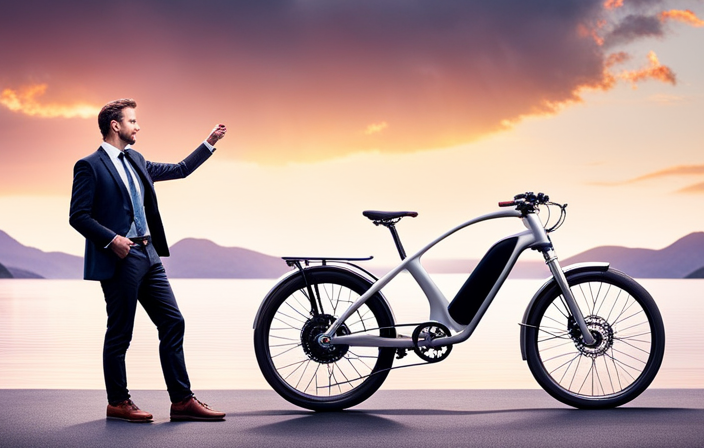I enjoy the sense of freedom that comes from riding an electric bike. The breeze in my hair, the open road in front of me, and the satisfaction of knowing I am contributing to a cleaner environment.
But there’s always one question that lingers in the back of my mind: how many miles can I go on a single charge?
In this article, we’ll dive deep into the world of electric bike batteries, exploring the factors that affect mileage, the range of different models, and the latest advancements in battery technology.
So buckle up, because we’re about to uncover the secrets behind maximizing your electric bike’s range.
Key Takeaways
- Battery capacity determines the mileage of an electric bike, with a range of 250 to 700 watt-hours.
- Factors such as terrain, rider weight, speed, and weather conditions can affect the mileage of an electric bike.
- Different electric bike models have varying battery capacities, with city commuter bikes offering 30 to 100 miles per charge.
- Optimizing battery usage and keeping the battery charged between 20% and 80% can help maximize the range of an electric bike.
Understanding Electric Bike Batteries
Electric bike batteries store energy that powers the bike’s motor. When it comes to electric bikes, one of the most important factors to consider is the battery capacity. The battery capacity determines how long the bike can run before needing to be recharged. Typically, electric bike batteries have a capacity ranging from 250 watt-hours to 700 watt-hours. The higher the capacity, the longer the bike can go on a single charge.
Charging time is another crucial aspect of electric bike batteries. It refers to the time it takes to fully charge the battery from empty to full. The charging time depends on various factors such as the battery capacity, charger power, and the type of charger being used. Generally, it takes anywhere from 2 to 8 hours to fully charge an electric bike battery. Some high-capacity batteries may even take longer.
Understanding battery capacity and charging time is essential for determining how many miles an electric bike can travel on a single charge. However, these are not the only factors that affect the bike’s mileage. Other factors such as rider weight, terrain, speed, and weather conditions also play a significant role.
Factors Affecting Mileage
To get the most out of your e-bike’s battery, you’ll want to consider factors like terrain, rider weight, and speed. These factors can greatly impact the range of your electric bike, and understanding their influence is crucial for maximizing your mileage. Let’s take a closer look at how each of these factors affects the battery life.
| Factor | Impact on Mileage |
|---|---|
| Terrain | Uneven or hilly terrain can significantly decrease battery range, as the motor has to work harder to overcome the obstacles. On the other hand, flat and smooth surfaces allow for more efficient riding and longer distances. |
| Rider Weight | Heavier riders require more power to propel the e-bike, which can reduce the mileage. It’s important to consider the weight capacity of your bike and choose one that suits your needs. |
| Speed | Riding at higher speeds consumes more energy. While it may be exhilarating to go fast, it’s worth noting that the battery will drain faster, resulting in a shorter range. Maintaining a steady and moderate speed can help maximize your mileage. |
| Battery Capacity | The size and capacity of your battery play a significant role in determining the range of your electric bike. Higher-capacity batteries generally offer longer ranges, but they may also be heavier and more expensive. |
Understanding these factors will help you make informed decisions when it comes to choosing the right electric bike for your needs. In the next section, we will explore the range of different electric bike models available in the market.
Range of Different Electric Bike Models
When it comes to electric bikes, there are various models available to suit different needs and preferences.
City commuter bikes are designed for urban environments, with features like fenders, lights, and a comfortable riding position.
Mountain bikes, on the other hand, are built for off-road adventures, with rugged frames, suspension systems, and knobby tires for better traction.
Lastly, folding bikes are perfect for those who need a compact and portable option, as they can be easily folded and stored in small spaces.
Each of these models offers its own unique advantages and it’s important to consider your specific requirements before making a decision.
City Commuter Bikes
City commuter bikes have become increasingly popular due to their convenience and eco-friendly features. As a regular commuter myself, I understand the importance of safety and the need for a reliable battery capacity.
When it comes to commuter safety, city bikes are designed with features such as durable frames, responsive brakes, and bright lights for enhanced visibility. These bikes also often come with fenders to protect riders from splashes and chain guards to prevent clothing from getting caught.
In terms of battery capacity, city bikes typically offer a range of anywhere from 30 to 100 miles per charge, depending on the specific model and battery size. This ensures that riders can comfortably travel to work and run errands without worrying about running out of power.
Transitioning to the next section, let’s now explore the world of mountain bikes and their unique features.
Mountain Bikes
Mountain bikes offer a thrilling and adventurous way to explore rugged terrains and conquer challenging trails. When it comes to electric bike performance, mountain bikes have made significant strides in recent years. The advancements in battery technology have greatly improved the battery range, allowing riders to go further and conquer more demanding trails. With the increased power and torque provided by the electric motor, riders can effortlessly climb steep hills and navigate rough terrains.
Additionally, the battery range of mountain bikes has significantly increased, enabling riders to cover longer distances on a single charge. This is especially beneficial for off-road enthusiasts who like to spend extended periods exploring remote areas.
Now, let’s transition to the subsequent section about folding bikes, which offer a different set of advantages and functionalities.
Folding Bikes
If you’re looking for a convenient and portable way to commute in urban areas, folding bikes are a great option. These compact bicycles offer several advantages that make them ideal for city living.
One of the main benefits of folding bikes is their portability. They can easily be folded up and carried onto public transportation or stored in small spaces, making them perfect for commuters who need to navigate crowded streets and tight living quarters. Additionally, folding bikes are typically lightweight, making them easier to maneuver and carry.
When it comes to choosing the best folding bike brand, some top contenders include Brompton, Dahon, and Tern. These brands are known for their high-quality construction, durability, and innovative folding mechanisms.
Now, let’s move on to battery management tips for electric bikes.
Battery Management Tips
To maximize the lifespan of your electric bike’s battery, make sure to avoid fully depleting it before recharging. This is crucial for optimizing battery usage and maximizing range. Lithium-ion batteries, which are commonly used in electric bikes, have a limited number of charge cycles. Each time you fully drain the battery, it counts as one cycle. By avoiding complete depletion, you can significantly extend the overall lifespan of your battery.
Additionally, it’s important to keep your battery charged between 20% and 80% whenever possible. This range is considered the sweet spot for battery health and longevity. Charging your battery beyond 80% or letting it drop below 20% frequently can put unnecessary strain on the cells, leading to faster degradation.
Another useful tip is to avoid exposing your electric bike’s battery to extreme temperatures. High heat or freezing temperatures can negatively impact the battery’s performance and overall lifespan. If you plan on storing your bike for an extended period, it’s best to remove the battery and store it in a cool, dry place.
By following these battery management tips, you can ensure that your electric bike’s battery lasts longer and provides you with optimal range.
Now, let’s explore the exciting advances in battery technology that are revolutionizing the electric bike industry.
Advances in Battery Technology
You’ll be amazed at the recent advancements in battery technology for electric bikes. The advantages of fast charging have revolutionized the way we think about electric bike batteries. With fast charging capabilities, you can now recharge your battery in a fraction of the time it used to take. This means less waiting around and more time on the road. Additionally, fast charging allows for more convenient charging options, as you can quickly top up your battery at a cafe or during a short break.
Another key factor to consider when it comes to battery technology is the impact of battery weight on performance. As batteries have become more powerful, they have also become lighter. This reduction in weight has a significant impact on the overall performance of the electric bike. Lighter batteries allow for better handling and maneuverability, making your rides more enjoyable and effortless.
Understanding pedal assist systems is the next step in maximizing the potential of your electric bike.
Understanding Pedal Assist Systems
When it comes to pedal assist systems, there are three key points to consider: levels of assist, maximizing efficiency, and balancing pedal power and electric power.
Understanding the different levels of assist allows riders to tailor their biking experience to their desired intensity and effort level.
Maximizing efficiency involves finding the optimal balance between using pedal power and electric power to get the most out of each charge.
Levels of Assist
The levels of assist on an electric bike determine how much power the motor provides. These levels are essential for balancing power and maximizing battery range. A higher level of assist means more power from the motor, which can be useful when going uphill or against strong headwinds. However, it also drains the battery faster. On the other hand, a lower level of assist conserves battery power and extends the range, but it might not be enough for challenging terrains. Finding the right balance is crucial to ensure a comfortable and efficient ride. Here is a table highlighting the different levels of assist and their corresponding power output:
| Level of Assist | Power Output |
|---|---|
| Low | 25% |
| Medium | 50% |
| High | 75% |
| Turbo | 100% |
Maximizing Efficiency
To maximize efficiency, it’s important to find the right balance between power and battery consumption on your e-bike. Maximizing range is a top priority for many e-bike riders, and there are several energy-saving techniques that can help achieve this.
One effective technique is to adjust the level of pedal assist based on the terrain and your own effort. By using a lower level of assist on flat or downhill sections, you can conserve battery power and extend your range.
Another technique is to maintain a steady and consistent speed, as sudden accelerations and decelerations can drain the battery more quickly. Additionally, keeping your tires properly inflated and minimizing drag by avoiding unnecessary accessories or modifications can also contribute to maximizing range.
By implementing these energy-saving techniques, you can get the most out of your e-bike and enjoy longer rides without worrying about running out of battery power.
Balancing pedal power and electric power is crucial for optimizing performance and range.
Balancing Pedal Power and Electric Power
You can find the right balance between pedal power and electric power by adjusting the level of assist on your e-bike. This allows you to maximize efficiency and effectively manage your battery. Here are three key points to consider:
-
Personalized Assistance: By adjusting the level of assist, you can tailor the amount of electric power to your needs. This enables you to conserve battery life when you have the energy to pedal more, or utilize more electric power when you need an extra boost.
-
Terrain Adaptability: Different terrains require varying levels of assistance. By adjusting the assist level, you can navigate uphill climbs more easily or conserve battery power when riding on flat ground.
-
Riding Style Flexibility: Whether you prefer a leisurely ride or a more intense workout, adjusting the assist level allows you to adapt your e-bike to your preferred riding style. This ensures that you can prolong your battery life while still enjoying the benefits of electric power.
By finding the right balance between pedal power and electric power, you can optimize your e-bike’s performance and maximize your battery’s longevity.
Now, let’s explore some real-life examples of electric bike range.
Continue reading to learn about real-life examples of electric bike range.
Real-Life Examples of Electric Bike Range
When it comes to electric bike range, there are three important scenarios to consider: commuting to work, long-distance touring, and off-road adventures.
Each of these situations presents different challenges and requirements for battery life and overall range.
In my experience, commuting to work typically requires a shorter range, as the distance traveled is often shorter and the bike can be charged during the workday.
However, for long-distance touring or off-road adventures, a longer range is crucial to ensure that you can cover the necessary distance without running out of battery power.
Commuting to Work
My electric bike can travel up to 40 miles per charge, making it a practical option for commuting to work.
The benefits of using an electric bike for commuting are numerous. Not only does it save money on gas, but it also reduces carbon emissions, contributing to a cleaner environment.
The cost of an electric bike may seem high initially, but when compared to the expenses associated with owning a car, it is a cost-effective alternative. Additionally, the maintenance costs for electric bikes are significantly lower than those for cars.
For daily commuting, an electric bike provides a convenient and eco-friendly mode of transportation.
As I transition into the next section about long-distance touring, it is important to note that the range of an electric bike may vary depending on factors such as terrain and battery capacity.
Long-Distance Touring
To embark on a long-distance tour, it’s essential to plan your route and ensure you have all the necessary supplies. Long distance rides require careful consideration of your bike range and the distance you can cover on a single charge.
Here are three key factors to consider for a successful long-distance tour:
-
Battery Capacity: Check the range of your electric bike and calculate how far you can go on a full charge. This will determine the distance you can cover each day and help you plan your route accordingly.
-
Charging Infrastructure: Research the availability of charging stations along your planned route. Make sure there are enough options to recharge your bike’s battery, especially if you are going through remote areas.
-
Spare Battery: Consider carrying a spare battery with you, especially if you are planning to cover a significant distance. This will provide you with an extra boost of power and give you peace of mind during your long ride.
With these considerations in mind, you can confidently embark on your long-distance adventure.
Now, let’s transition into the next section about off-road adventures.
Off-Road Adventures
With proper preparation, you can enjoy thrilling off-road adventures on your electric bike. Off-road trails provide a unique and exhilarating experience, but it’s important to consider your electric bike’s battery range.
The battery range determines how far you can go before needing to recharge. When riding off-road, the battery range may vary due to factors such as uneven terrain and increased power demands. To ensure a successful off-road adventure, it’s crucial to plan your route carefully and be aware of the battery range of your electric bike. This will help you avoid running out of power in the middle of nowhere.
Now, let’s explore strategies for extending battery life and maximizing your off-road adventures.
Strategies for Extending Battery Life
Using regenerative braking is a key strategy for extending the battery life of an electric bike. This technology allows the bike to convert the kinetic energy generated during braking into electrical energy, which is then stored in the battery for later use.
Another effective strategy is planning efficient routes that minimize uphill climbs and maximize downhill descents, reducing the overall energy consumption of the bike.
Lastly, carrying spare batteries can provide peace of mind on longer rides, ensuring that you have enough power to reach your destination without running out of battery.
Using Regenerative Braking
Regenerative braking helps the electric bike recover energy and extends the miles per charge. This innovative technology allows the bike to convert kinetic energy into electrical energy while braking or decelerating.
One of the advantages of regenerative braking is that it allows the battery to be charged while riding, which can significantly increase the overall range of the electric bike. By harnessing the energy that would otherwise be wasted during braking, regenerative braking helps to optimize the efficiency of the bike’s battery.
However, it is important to note that while regenerative braking can extend the miles per charge, the actual impact on battery life may vary depending on factors such as riding conditions and individual usage patterns.
With regenerative braking in mind, let’s now delve into the next section about planning efficient routes.
Planning Efficient Routes
Planning efficient routes can help maximize the range of my electric bike and minimize the need for frequent charging. By following a few simple strategies, I can optimize the battery range and make the most out of each charge.
Here are three key factors to consider when planning efficient routes:
-
Avoiding steep inclines: Climbing uphill requires more energy and drains the battery faster. By choosing routes with gentle slopes, I can conserve battery power and extend my range.
-
Minimizing stop-and-go traffic: Constant acceleration and braking can be energy-intensive. Opting for routes with fewer traffic lights and stop signs allows me to maintain a steady speed and reduce energy consumption.
-
Utilizing bike lanes and dedicated paths: Riding on roads with designated bike lanes or dedicated cycling paths not only enhances safety but also ensures a smoother, uninterrupted ride. This can help conserve energy and prolong the battery life.
By efficiently planning my routes, I can optimize the battery range of my electric bike and enjoy longer rides without worrying about running out of power.
Carrying spare batteries is another option to consider to further extend my range and provide peace of mind during longer journeys.
Carrying Spare Batteries
When you’re out on longer rides, it’s a good idea to carry spare batteries for your electric bike. Having spare battery options ensures that you won’t be left stranded if your primary battery runs out of charge.
There are a few factors to consider when choosing spare batteries. Firstly, you should check the compatibility with your electric bike model. It’s also important to consider the capacity and voltage of the spare battery to ensure it will provide enough power to sustain your ride. Additionally, battery charging time is a vital aspect to consider. Some batteries may require a longer time to fully charge, so it’s important to plan your charging schedule accordingly.
By having spare batteries and understanding their charging time, you can extend the range of your electric bike and enjoy longer rides without worrying about running out of power.
Moving on to electric bike range calculators and apps, they provide valuable information to help plan your rides more efficiently.
Electric Bike Range Calculators and Apps
When it comes to determining the range of an electric bike, there are several tools and resources available.
Online range calculators can provide an estimate based on factors such as battery capacity, terrain, and rider weight.
Smartphone apps, on the other hand, offer real-time monitoring of battery levels and can provide more accurate range calculations based on current conditions.
Additionally, user-generated data from electric bike riders can also be a valuable source of information, as it offers real-world insights and experiences that can help others gauge the range of their own electric bikes.
Online Range Calculators
If you’re curious about the range of your electric bike, online range calculators can help you estimate how many miles you can go on a single charge. These calculators take into account factors such as the battery capacity, motor power, and terrain to provide an accurate range estimation.
Here are some key points to consider when using online range calculators:
- Electric bike range comparison:
- Compare the range of different electric bike models to find one that suits your needs.
- Look for user reviews and ratings to get a better understanding of real-world range.
- Consider the manufacturer’s claimed range, but keep in mind that it may not always be accurate.
Tips for increasing electric bike mileage:
- Keep your tires properly inflated to reduce rolling resistance.
- Use pedal assist mode instead of relying solely on the throttle.
- Avoid excessive acceleration and maintain a steady speed.
By using these online range calculators and implementing these tips, you can maximize the mileage of your electric bike.
Now let’s explore how smartphone apps can further enhance your electric biking experience.
Smartphone Apps
Smartphone apps can enhance your electric biking experience by providing real-time navigation, tracking your rides, and offering useful features like weather updates. These apps not only make it easier to plan routes and explore new areas, but they can also help you keep track of your battery life and monitor your smartphone charging while on the go. With the ability to connect to your electric bike’s battery, these apps can provide accurate battery monitoring and alerts, ensuring you never run out of power during your rides. To give you an idea of the different smartphone apps available for electric bikers, here’s a table showcasing some popular options:
| App Name | Features |
|---|---|
| Bike Maps | Real-time navigation, route planning |
| Strava | Ride tracking, performance analysis |
| AccuWeather | Weather updates, forecasts |
| Komoot | Outdoor navigation, offline maps |
| Ride with GPS | Route planning, turn-by-turn directions |
User-Generated Data
To maximize your electric biking experience, you can benefit from the user-generated data shared within the community. Real world experiences, challenges, and solutions are invaluable when it comes to electric biking.
Here are three key reasons why user-generated data is essential for electric bike enthusiasts:
-
Range Optimization: By sharing data on the actual distance traveled on a single charge, users can help others optimize their electric bike’s range. This data allows riders to plan their routes more effectively and avoid running out of power in the middle of their journey.
-
Battery Performance: User-generated data provides insights into the performance of different electric bike batteries. This information helps riders make informed decisions when purchasing a new battery or maintaining their existing one.
-
Troubleshooting and Maintenance: Sharing data about common issues and their solutions can help electric bike riders troubleshoot problems and perform necessary maintenance. This collective knowledge can save time and money, ensuring a smoother riding experience.
Environmental Benefits of Electric Bikes
Electric bikes offer a greener transportation option with their environmental benefits. Not only do they reduce carbon emissions, but they also contribute to less noise pollution and help alleviate traffic congestion. To fully take advantage of the environmental benefits of electric bikes, it is important to have proper electric bike infrastructure in place. This includes designated bike lanes and charging stations that make it easier for riders to commute using their electric bikes.
In addition to their positive impact on the environment, electric bikes also provide numerous health benefits. Riding an electric bike can be a great form of exercise, particularly for those who may have physical limitations or are just starting to incorporate physical activity into their daily routine. It allows individuals to gradually increase their fitness levels and can help improve cardiovascular health.
Transitioning into the subsequent section about safety considerations for electric bike riders, it is important to note that while electric bikes offer many advantages, there are also safety considerations to keep in mind.
Safety Considerations for Electric Bike Riders
When it comes to safety considerations for electric bike riders, there are three key points that need to be addressed.
First, wearing a helmet and other protective gear is essential to protect oneself in case of accidents or falls.
Second, riders must familiarize themselves with local traffic laws and regulations to ensure they are riding safely and legally.
Lastly, maintaining proper visibility and using appropriate lighting is crucial for both the rider’s safety and alerting other road users to their presence.
Helmet and Protective Gear
Make sure you wear your helmet and protective gear whenever you ride your electric bike to ensure your safety. It’s not just a precautionary measure, but a necessity that can save your life.
When it comes to helmet design, there are several key factors to consider. First, look for a helmet that is certified by safety standards such as the CPSC (Consumer Product Safety Commission) or ASTM (American Society for Testing and Materials). These certifications ensure that the helmet meets minimum safety requirements. Additionally, consider the fit of the helmet. It should be snug but not too tight, with adjustable straps to keep it securely in place. Finally, look for helmets with additional safety features such as reflective elements or built-in lights for increased visibility on the road.
Now that you’re equipped with the right gear, let’s dive into the next important aspect of electric bike safety: traffic laws and regulations.
Traffic Laws and Regulations
To ensure your safety on the road, it’s important to familiarize yourself with the traffic laws and regulations that apply to riding your electric bike. Understanding these laws will not only help you avoid fines and penalties but also contribute to reducing traffic congestion and promoting road safety.
Some key regulations include obeying traffic signals and signs, using designated bike lanes where available, and yielding to pedestrians. It’s crucial to ride in a predictable and visible manner, especially during peak traffic hours. By following these rules, you can enhance your safety and contribute to a smoother flow of traffic.
Now, let’s move on to the next important aspect of riding an electric bike: visibility and lighting.
Visibility and Lighting
As a cyclist, it’s crucial to prioritize safety and visibility on the road, especially when riding at night or in low-light conditions. One effective way to enhance visibility is by investing in proper bike lighting. Here are three essential tips for improving visibility while cycling:
-
Install front and rear lights: Equip your electric bike with a powerful front light and a bright rear light. This will significantly increase your visibility to other road users, allowing them to see you from a distance.
-
Use reflective accessories: Attach reflective materials to your bike, such as reflective tape on the frame, pedals, and wheels. These accessories will reflect light back to its source and make you more visible in the dark.
-
Wear high-visibility clothing: Opt for bright, fluorescent colors or clothing with reflective strips. This will make you more noticeable to drivers, especially during the daytime.
By implementing these visibility tips, you can greatly reduce the risk of accidents and ensure a safer ride.
Now let’s dive into testimonials from electric bike owners who have experienced the benefits of extended mileage per charge.
Testimonials from Electric Bike Owners
As an electric bike owner, I’ve had the opportunity to experience the benefits of using an e-bike for commuting, recreational riding, and embracing an eco-conscious lifestyle.
Commuting with an electric bike has not only allowed me to avoid traffic and arrive at work feeling energized, but it has also significantly reduced my carbon footprint.
Additionally, I’ve discovered the joy of exploring new trails and scenic routes during my recreational rides, all while knowing that I’m contributing to a cleaner environment.
Commuter Experiences
My friend said they’ve had a great experience commuting with their electric bike. Electric bike commuting has become increasingly popular due to its numerous advantages. Here are some key points to consider:
-
Safety: Electric bikes are equipped with safety features such as lights, reflectors, and horns, ensuring a safe ride during any time of the day.
-
Convenience: Commuting with an electric bike allows you to avoid traffic congestion and find parking easily, making your daily commute more efficient.
-
Cost-effective: Electric bikes are a cost-effective alternative to traditional transportation methods. They require less maintenance, no fuel, and have minimal operating costs.
-
Health benefits: Riding an electric bike to work provides a great opportunity to incorporate exercise into your daily routine, promoting a healthier lifestyle.
With these benefits in mind, it’s clear why electric bike commuting has gained popularity.
Transitioning to the next section, recreational riding also offers its own unique advantages.
Recreational Riding
Looking to unwind and have some fun? Riding a bicycle for recreation is a fantastic way to enjoy the outdoors and get some exercise at the same time.
When it comes to recreational riding, there is a choice between pedal power and electric power. Pedal power offers a more traditional and physically demanding experience, allowing you to fully engage your muscles and cardiovascular system. On the other hand, electric power provides an extra boost, making it easier to tackle hills or ride for longer distances without getting tired.
Regardless of the power source, recreational riding offers numerous health benefits. It improves cardiovascular fitness, strengthens muscles, and helps maintain a healthy weight. Additionally, spending time outside and soaking up the fresh air can reduce stress and improve mental well-being.
So, whether you choose pedal power or electric power, recreational riding is a great way to stay active and enjoy the beauty of nature.
As we transition into the next section about the ‘eco-conscious lifestyle,’ we can explore how recreational riding also aligns with sustainable practices.
Eco-Conscious Lifestyle
Riding a bicycle for recreation is a fantastic way to enjoy the outdoors and reduce our carbon footprint. By using pedal power instead of relying on fossil fuels, we can actively contribute to reducing carbon emissions and preserving the environment.
Not only does cycling provide a great workout, but it also allows us to explore our surroundings at a leisurely pace. As we pedal along, we can admire the beauty of nature and feel a sense of connection to the world around us. Plus, cycling is a cost-effective and sustainable mode of transportation that promotes a healthier lifestyle.
Transitioning into electric bike maintenance tips, it is important to ensure that our bikes are in proper working order to maximize their efficiency and longevity.
Electric Bike Maintenance Tips
To keep your electric bike running smoothly, make sure to regularly check the tire pressure and clean the chain. Proper maintenance is essential for maximizing the lifespan of your electric bike and ensuring optimal performance.
In addition to these basic maintenance tasks, there are a few other important aspects to consider when it comes to electric bike maintenance.
One of the key components of an electric bike is its battery. To get the most out of your battery, it’s important to follow proper charging techniques. This includes charging the battery fully after each ride and avoiding overcharging or undercharging. It’s also recommended to store your battery in a cool and dry place when not in use.
Inevitably, you may encounter some common issues with your electric bike. Troubleshooting these issues can help you get back on the road quickly. Some common problems include a loss of power, issues with the motor, or problems with the brakes. By familiarizing yourself with the troubleshooting techniques specific to your electric bike model, you can address these issues efficiently.
Now that we’ve covered some essential maintenance tips and troubleshooting techniques, let’s explore the different charging options available for electric bikes.
Charging Options for Electric Bikes
One of the most convenient charging options for electric bikes is using a portable charger. These compact devices allow me to charge my bike’s battery wherever I go, providing me with flexibility and peace of mind. Not only are portable chargers easy to carry around, but they also offer fast charging capabilities, ensuring that I can quickly recharge my electric bike and get back on the road in no time.
Another exciting charging option for electric bikes is harnessing the power of the sun through solar panels. Solar power is a clean and renewable energy source that can be used to charge electric bike batteries. By installing solar panels on my home or even on my bike itself, I can take advantage of this sustainable solution and reduce my reliance on traditional electricity sources.
With the increasing popularity of electric bikes and advancements in technology, the future of electric bike charging looks promising. Innovations such as wireless charging and even more efficient solar panels are already being explored. These developments will make charging even more seamless and convenient, allowing electric bike riders like me to enjoy longer rides without worrying about running out of power.
Future of Electric Bikes
The future of electric bikes is incredibly exciting. Advancements in technology and a growing market demand are driving innovation in various areas. One key aspect is the integration of electric bikes with smart cities. These bikes can play a crucial role in providing sustainable transportation options.
Innovations in battery technology are continuously improving the range, efficiency, and charging times of electric bikes. This makes them even more practical and convenient for everyday use. As a result, the market for electric bikes is experiencing significant growth.
Trends indicate a shift towards eco-friendly transportation solutions. The demand for electric bikes is expected to continue rising as more people prioritize sustainability and seek alternative modes of transportation.
Integration with Smart Cities
You can easily see how electric bikes integrate with Smart Cities by observing the increased number of charging stations and bike lanes.
As cities around the world embrace the concept of smart city infrastructure, electric bikes are becoming an integral part of the transportation system. Many cities have implemented electric bike sharing programs, allowing residents and tourists to conveniently rent and ride electric bikes to get around. These programs not only promote sustainable transportation but also reduce congestion and air pollution.
With the growing popularity of electric bikes, cities are investing in the necessary infrastructure to support them, including the installation of charging stations and the creation of dedicated bike lanes. This seamless integration of electric bikes into smart city ecosystems paves the way for further innovations in battery technology, allowing for longer and more efficient rides without the need for frequent recharging.
Innovations in Battery Technology
To fully experience the benefits of electric bikes, it’s essential to keep up with the latest innovations in battery technology. As battery technology continues to advance, electric bikes are becoming more efficient and reliable. Here are some key innovations in battery technology that are shaping the future of electric bikes:
- Lithium-ion batteries: These batteries offer higher energy density and longer lifespan, providing increased range and durability.
- Fast charging: With advancements in battery charging techniques, electric bike batteries can now be charged quickly, allowing for shorter charging times and more convenience.
- Regenerative braking: This innovative feature allows the battery to be charged while braking or going downhill, maximizing the bike’s range and energy efficiency.
- Integration of alternative energy sources: Electric bikes are now being designed to incorporate alternative energy sources such as solar panels, allowing for sustainable charging options.
- Smart battery management systems: These systems optimize the battery’s performance, ensuring efficient energy usage and prolonging the battery’s lifespan.
With these innovations in battery technology, electric bikes are becoming more practical and efficient, making them a viable transportation option for many.
Now, let’s explore the market growth and trends in the electric bike industry.
Market Growth and Trends
With the market for electric bikes rapidly expanding, it’s important to stay informed about the latest trends and growth in this industry. Market competition in the electric bike industry is fierce, with manufacturers constantly striving to meet consumer preferences and stay ahead of the curve. One of the key trends in this market is the increasing demand for electric bikes with a longer range per charge. Consumers want to be able to travel longer distances without worrying about running out of battery power. This has led to innovations in battery technology and the development of electric bikes that can travel up to 100 miles on a single charge. The table below showcases some of the top electric bikes on the market and their range per charge, giving consumers a clear comparison of their options.
| Electric Bike Model | Range per Charge (miles) |
|---|---|
| Bike A | 80 |
| Bike B | 100 |
| Bike C | 60 |
| Bike D | 90 |
As the market for electric bikes continue to grow, it is evident that consumer preferences are shifting towards electric bikes with longer range per charge. This trend has sparked intense competition among manufacturers, pushing them to develop more efficient battery technology and improve the overall performance of electric bikes. By providing consumers with a variety of options that offer longer ranges, manufacturers hope to attract a wider customer base and cater to the needs of different riders. In conclusion, staying informed about the latest market trends and innovations is crucial for both manufacturers and consumers in the rapidly expanding electric bike industry.
Frequently Asked Questions
How much does an electric bike cost?
An electric bike provides a cost-effective transportation option compared to a scooter. It offers numerous benefits such as reduced carbon emissions and lower maintenance costs. The price of an electric bike can vary but generally ranges from a few hundred dollars to a few thousand dollars.
Can I ride an electric bike in the rain?
Yes, you can ride an electric bike in the rain. To ensure safety, adjust your riding technique by using smoother movements and braking earlier. Additionally, regularly clean and lubricate the bike’s components to prevent any potential damage from moisture.
Are electric bikes legal to ride on the road?
Yes, electric bikes are legal to ride on the road, but there are specific electric bike regulations that vary by country and state. It’s important to be aware of safety concerns and follow traffic laws to ensure a safe riding experience.
How long does it take to fully charge an electric bike battery?
Charging an electric bike battery takes a reasonable amount of time, depending on factors like battery capacity and charging speed. Generally, it can take anywhere from 3 to 6 hours to fully charge. The lifespan of electric bike batteries varies, but they typically last for several years with proper care.
Can I add an extra battery to increase the range of my electric bike?
Yes, you can increase the range of your electric bike by adding an extra battery. This will increase the battery capacity, allowing you to travel longer distances. However, there are pros and cons to consider, such as added weight and cost.
Conclusion
In conclusion, electric bikes have come a long way in terms of battery technology and range. With advancements in battery technology, electric bikes can now travel longer distances on a single charge.
In fact, according to a recent study, the average electric bike can travel up to 50 miles per charge. This is a significant improvement from just a few years ago.
With proper battery management and maintenance, electric bike owners can maximize their mileage and enjoy longer rides.
The future of electric bikes looks promising, with even more advancements on the horizon.
















